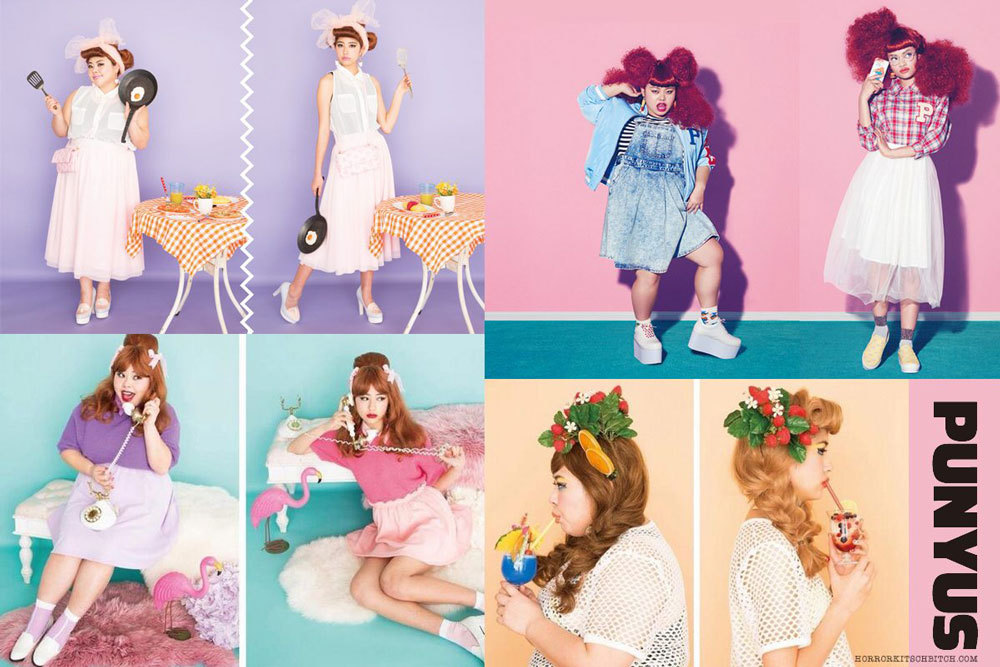In the modern society of the 20th century, formal fashion was a significant part in perpetuating the ideas of gender boundaries. Back then, this was more evident in businesswear, which possesses inherent values and influences that correspond to cultural norms found in the West such as professionalism and individualism.
Traditional gender norms and stereotypes were strengthened by marketing strategies, consumer behaviour, and social expectations. However, as people challenged these distinctions through self-expression and cultural intersection, fashion had the potential to be a tool for empowerment and artistry. Discover how renowned Japanese designers like Rei Kawakubo and Issey Miyake went beyond the traditional by incorporating their roots with Western and Eastern inspiration in coming up with statement collections.
The Conventions of Modern Formal Fashion
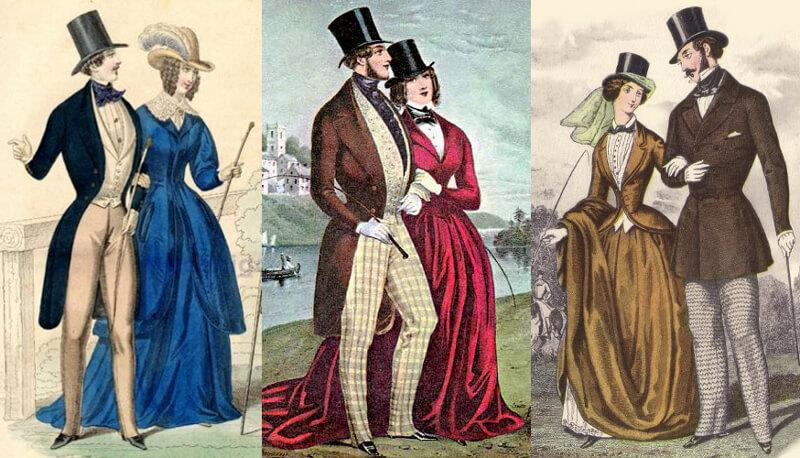
Image Credit: Vintage Fashion
In contemporary, capitalist, industrialized countries, the businessman’s suit has become so commonplace that it is practically unnoticeable. A man can blend in with his surroundings by donning a business suit in a blue shade of navy or grey, along with a white or pale blue shirt and necktie. Since the early 19th century, the suit has stood for the bourgeois ideals of propriety, restraint, caution, and detachment.
In contemporary capitalist cultures, the customs of males wearing sombre, well-cut clothing and women wearing colourful clothing that emphasizes their bodies’ shapes further reinforce gender boundaries. The shape of a suit no longer receives much attention, while the artificiality of corsets and “wonderbras,” which enhance women’s hourglass form. It places less emphasis on the padded shoulders of men’s suits. People often fail to recognize that the hourglass shape of the corseted woman and the square shoulders of the business suit is equally unnatural.
Breaking Gender Boundaries: Revolutionizing Japanese Businesswear Fashion

Image Credit: HR Asia
Similar to the Western culture, Japan’s fashion industry has a long history of upholding strict gender boundaries, especially in businesswear fashion. These gender distinctions, which have their roots in societal and cultural standards, have influenced the landscape of business clothing for many years. In Japan, traditional gender roles have emphasized different standards for men and women in both the personal and professional spheres. This has resulted in distinct dress codes and norms at work. While women were encouraged to don fitted skirt suits or skirts to portray elegance and grace, males were supposed to don black suits to convey authority and seriousness. These expectations strengthened society’s standards and maintained a binary view of appropriate professional clothing.
The emphasis on hierarchy, formality, and group harmony has shaped the country’s business culture and fashion preferences. In this context, traditional gender roles in business attire served to uphold the status quo. The conservative approach aimed to sustain a unified and peaceful professional environment, where conforming to accepted norms was valued more than individual expression.
Since then, there has been an observation of fashion moving towards fostering a more inclusive and diverse understanding of professionalism and reimagining businesswear fashion. Fashion designers around the world even started to create their take on reconstructed gender-bound fashion staples to spark a global shift towards more inclusive and diverse fashion.
While traditional fashion in the past promotes gender stereotypes, certain designers, like Rei Kawakubo, call attention to these stereotypes and even make attempts to deconstruct them.

Image Credit: The New Yorker
In 1942, Rei Kawakubo was born in Tokyo, Japan. Before pursuing a career in fashion, she attended Keio University to study literature and visual arts. Kawakubo carved her position in the fashion business by differentiating her works from conventional ideas of femininity and beauty. She has pushed boundaries, altered beauty standards, and challenged norms with her avant-garde creations and fearless attitude to fashion. Through this, Kawakubo has promoted gender-neutral fashion and the celebration of personal expression that goes beyond cultural standards.
In 1969, she founded Comme des Garçons (meaning “like boys” in French). It was a brand that would become synonymous with her avant-garde and boundary-breaking designs. In garments from the Comme des Garçons Spring/Summer 1995 collection, Rei Kawakubo plays with the expectations of feminine and masculine dress by mixing these gendered styles. A frilly and frivolous skirt billows from under the sober business-style jacket of a female model. A male model’s pinstriped coat is sleeveless, revealing a sheer, short-sleeved shirt.
Revolutionizing Menswear: Rei Kawakubo’s Avant-Garde Deconstructions
In another range, Homme Deux, Rei Kawakubo’s menswear collection housed under the same brand, represents an important development in the world of menswear. Kawakubo challenges conventional ideas of masculinity in Japanese Fashion with her avant-garde designs and rebellious personality, revolutionizing the menswear industry.
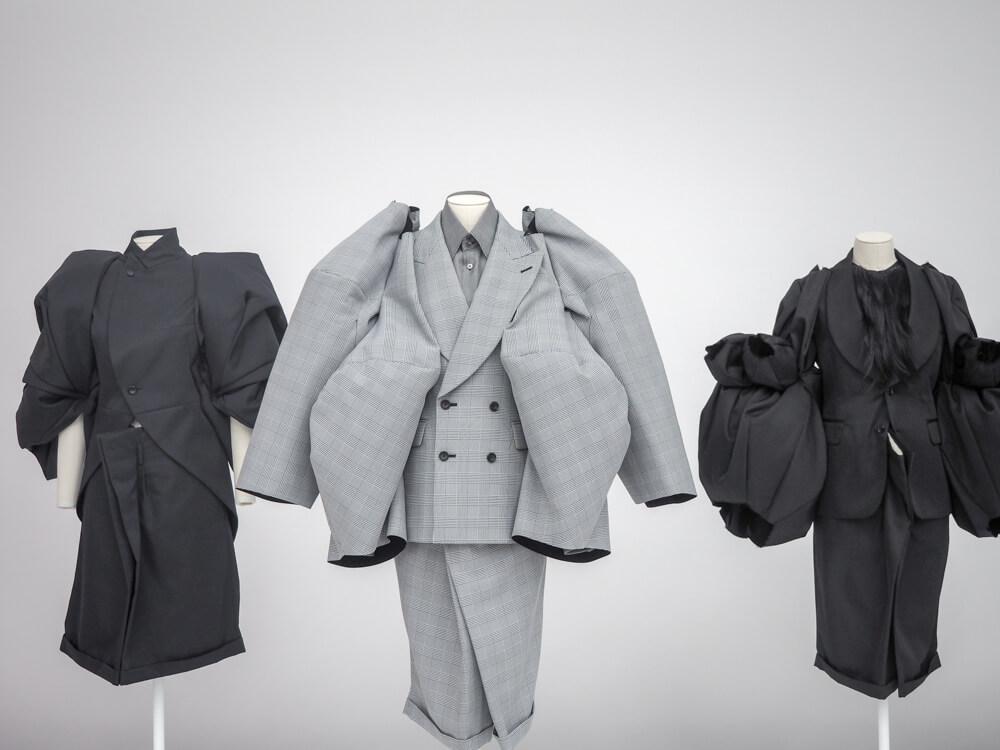
Image Credit: Rikumo
This exhibition’s deconstructed patch jacket demonstrates how menswear fashion trends are created. By refusing to appear seamless, the jacket breaks the traditional business suit. Patches of several suiting fabric types appear to run in various directions. Every seam and thread as well as every fabric fragment are visible in the designer’s garment.

Design from the Rei Kawakubo/Comme des Garçons: Art of the In-Between collection
Image Credit: Art Forum
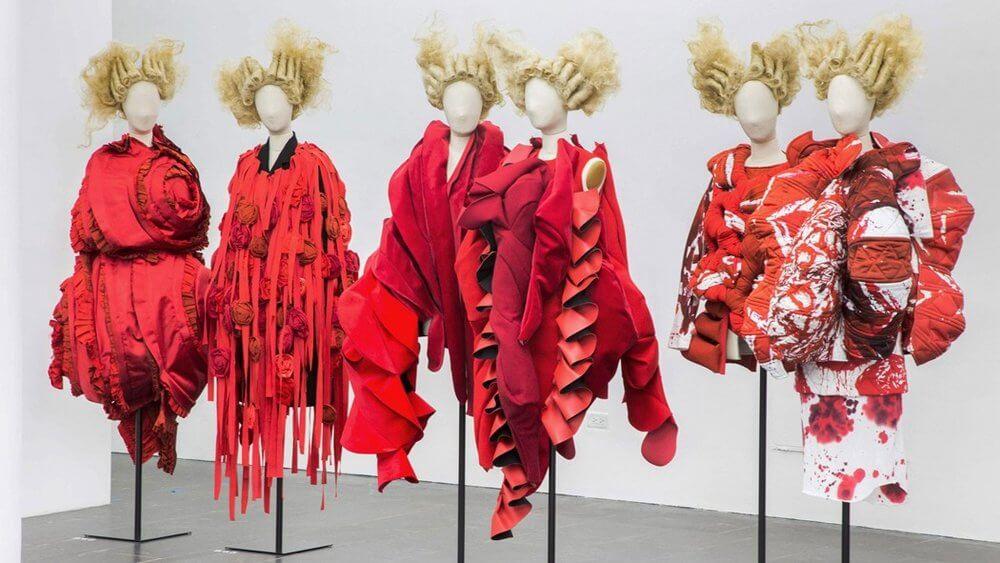
Designs from the Rei Kawakubo/Comme des Garçons: Art of the In-Between collection
Image Credit: The Modern Renaissance
One may argue that Kawakubo is deconstructing clothing in Japanese Fashion. Both physically by exposing its component pieces and symbolically by rendering the supposedly utilitarian decorative and non-functional. She challenges our perceptions of ornamentation and purpose in the process. Kawakubo’s disassembled jacket serves as a reminder that clothing is anything but “seamless”. Someone had to sew it together, whether by hand, machine, or a combination of these methods.
Western European Art in Issey Miyake’s Dresses

Image Credit: Financial Times
Issey Miyake, who is known for his innovative designs, forward-thinking approach, and pioneering use of technology, is another influential Japanese designer. He was born in 1938 in Hiroshima, Japan. Before entering the Japanese Fashion industry, he attended the Tama Art University in Tokyo to study graphic design. Miyake transforms his ideas into wearable art forms by drawing inspiration from a variety of areas. They are art, architecture, and nature. He embraces asymmetry, proportions, and unique forms in his designs. Defying conventional ideas about how clothes are typically put together. Miyake’s creations are more than just clothes; they push the limits of creativity and inspire others to use fashion as a form of self-expression.
While some of the Japanese designs, including those of Kawakubo, resist the characteristic sculpturing of the haute couture style. On the other hand, Issey Miyake’s dresses displace the pleasures of gazing at the body differently.
The Pleated Dress with Seven Hoops (1995)
The wiring used in The Pleated Dress with Seven Hoops (1995) resembles the crinolines of the Victorian era. The Victorian era’s crinolines and corsets were designed to emphasize the small waists and large hips of female bodies. However, Miyake’s wired garment disregards the natural body’s curves.
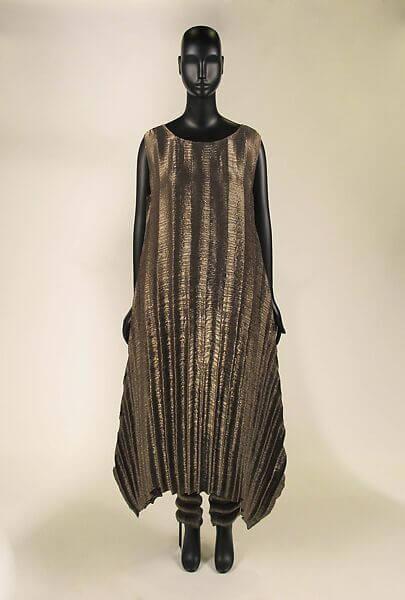
Image Credit: MET Museum
Rectangular shapes are used in The Pleated Brown Evening Ensemble (1989), which is reminiscent of the kimono. However, unlike the kimono, which securely binds the body, the rectangular shapes in the Pleated Brown Evening Ensemble protrude from the body.
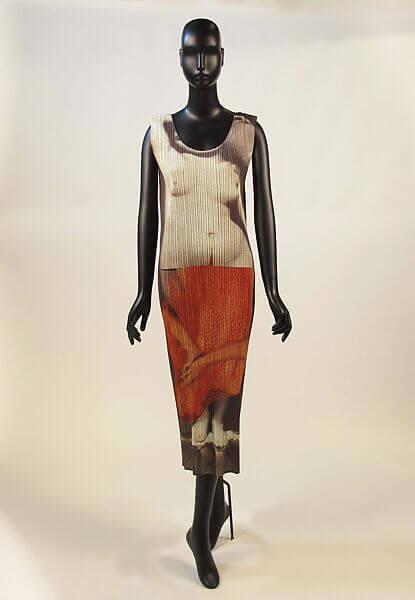
Image Credit: MET Museum
Prints that are collages of a nude from a painting by Jean Auguste Dominique Ingres (1780-1867). It embellishes the front and back of the Miyake/Morimura dress from 1997. Additionally an image of Morimura’s own body. It also has the Ingres image on the upper half of the dress (which covers the torso) in black and white tones. Finally the upside-down Morimura image in burnished tones on the lower half. However, in-depth cultural expertise is required to fully read this masterpiece. The canon of Western European visual art includes Ingres firmly. A late 1930s art historian believed that his work exemplified “the art of the European race.”
The effect of the printed image is to displace the attention which would normally focus on the interplay between the body of the wearer and the fabric and flow of the garment. Attention, rather, is on the nude figure. The viewer is thus provided with the pleasure of gazing at the naked female body. The actual body of the female model displaces his pleasure. Or, to be more precise, the gaze is on the interaction between the body, the fabric of the dress, Ingres’ nude, and the image of the body of Morimura. Issey Miyake’s Dress with European paintings stands as a testament to his visionary approach to design. Consequently forging new paths in the exploration of Japanese Fashion as wearable art.








































